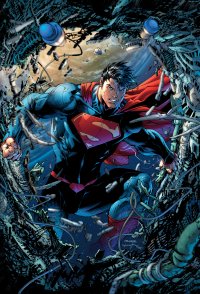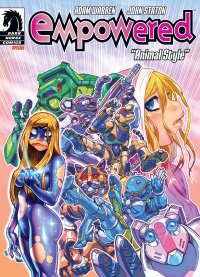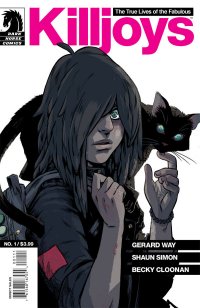Superman Unchained #1 (DC Comics, $4.99)
By Devon Sanders (@devonsanders)
Since the release of the first Man Of Steel movie trailer, it feels as though all I’ve done is defend Superman.
“He’s boring.”
“He’s too damned powerful.”
“I can’t relate to him. He’s not human.”
“He’s too good.”
Now, this last one… this last one is the one that kills me; “He’s too good.”
When did being “too good” become an impediment? When did it become a deal-breaker? I get it, though. We live in a world where many believe that Mister Rogers simply couldn’t have been a man that just wanted to do good. No, we were cynical and tacked on a story where he turned his back on his life as a former Navy SEAL and vowed never to be angry again.
(pause)
No.
Fred Rogers was a good man. Plain. Simple. A good man.
He always found the commonality within us; he found his calling in service to others. He was unflappable and yes, a bit square but that was just him. He was on a constant quest to help us overcome our fears and find answers. In him, we saw the best of our humanity. He simply believed in us, as a people.
Sound familiar?
75 years on and Superman is still here fighting the never-ending battle in a new title, Superman Unchained #1, written by Batman’s Scott Snyder and drawn by Justice League‘s Jim Lee.
1945, over the skies of Japan, not a bird but a plane unleashes a deadly payload, forever changing history. Today, 8 objects fall from the heavens and Superman is there. Lives are saved and the world is once again given over to celebration. 8 objects fell from the sky and the ever observant Lois Lane points out that only 7 were truly accounted for with the final one unlocking a secret 75 years in the telling.
Scott Snyder does a great job in capturing the things that make Superman great, mainly his humanity. In Superman’s internal monologues, he refers to himself as “Clark” while constantly asking himself to “think”. To me, this was the deal-sealer. Snyder’s Superman is the guy you want around when things go, “BOOM!” He constantly implores himself to push himself and think, leading always towards action. He’s not afraid to check himself. In that, Snyder has given us a Superman/Clark Kent who’s human and something more. He gives us a Jimmy Olsen people can wrap their heads around and the Lois Lane I’ve personally been waiting for since the beginning of the New 52.
Jim Lee’s art is the best I’ve seen it in a while. When given time, Lee can still surprise and entertain. No greater example of this can be found than on the giant (and somewhat unwieldy and not entirely necessary) double four page spreads contained in this issue. Lee’s Superman truly is something to behold; all lean muscle, superheroic poses and a reassuring smile. My biggest hope here is that deadline pressures don’t creep in and we continue to see Lee try new things.
Superman Unchained #1 is a fun, intriguing addition to the Superman mythos This feels fresher and newer than what’s current carrying the “S” on comics racks and more importantly, accessible. I came more for Superman but will be staying more for Superman’s interactions with the greater world. Snyder and Lee’s Superman is just a very good man. It took two years. I’m glad he’s finally here.
Rating: 




Out of a Possible 5 Stars
 Six-Gun Gorilla #1 (BOOM!, $3.99)
Six-Gun Gorilla #1 (BOOM!, $3.99)
By Adam Prosser
There are some subgenres that are forever associated with a particular era, and pulp is probably the apotheosis of this. Even though it technically just describes a style of writing, one that isn’t all that clearly defined, when we hear “pulp” we tend to picture old-fashioned adventure stories, often with a SF or fantastical bent, produced before, during or just after the WWII era. Students of pulp, like the redoubtable Jess Nevins, can point out the various branches, styles and shadings of the subgenre, but to most casual fans the idea of “pulp adventure” has been firmly affixed in our minds by the likes of George Lucas and Joe Johnston. Which is a bit ironic, because of course what these folks are producing is deliberately retro modern storytelling. Something like The Rocketeer or Mike Mignola’s Lobster Johnson may capture the basic spirit of the classic pulps, but it’s a burnished, polished, nostalgic version that smooths off the rough edges of that whole era of publishing. Specifically: just how weird it could be.
Case in point: in the 30s, a British pulp magazine called Wizard (no relation to the 90s hype-fest, I assume) published a serial featuring a circus gorilla in the old west who was rescued from a train crash by a kindly prospector. After raising him to adulthood, the prospector was murdered by bandits, and the gorilla strapped on six-guns and set off for revenge. This was played absolutely straight by its author, whose name has been lost to history, as was the story itself until Mr. Nevins dug it up as part of his invaluable pop culture scholarship. And since EVERYTHING IS REBOOTS now, Simon Spurrier (of X-Men Legacy and Judge Dredd fame) has gifted the world with a new series that takes the idea of a gunslinging ape (and very little else) and ups the ante on weirdness by about a thousand.
The new series is SF, set on another planet far in the future that’s apparently fighting for its independence from Earth. For whatever reason, standard technology that relies on electricity and combustion doesn’t work on this world, so weapons take on a variety of bizarre forms, like wind-up clockwork guns and “choirshot” (a heavenly choir that apparently melts you into atoms if it gets close enough). What’s more, the shock troops of Earth’s army are comprised entirely of suicidal folks who are implanted with “psychic tumours” that transmit their experiences, Being John Malkovich-style, back to a virtual reality viewing audience at home who are lusting for vicarious thrills; the war is as much about entertainment as it is principles or politics.
Our lead character is Blue-3425, a former librarian who’s decided to end his existence in as dramatic a fashion as possible after a bad breakup, but who finds himself wrangled into an obligation that forces him to stay alive a while longer. Into this madness comes the titular character, seeming downright normal in context, and ripe for a team-up with our hero.
It’s clear Spurrier is Going Somewhere with all this; in addition to all the crazy concepts introduced (with laudable narrative efficiency) in this issue, there’s hints of some kind of larger, metatextual commentary; the opening page spills over from the dedication to “creator unknown” into the actual story, and it’s surely not a coincidence that Blue was in charge of the pulp section back at the library. Exactly what the larger ideas of this story are going to be isn’t clear, of course–though there’s a suggestion that the Blisterworld (where all this is taking place) is somehow a story that can be physically entered–but this certainly isn’t one of those first issues that’s slow to start. Even if you don’t care about the craziness and just want a fun action romp, Spurrier and artist Jeff Stokely provide, with a major battle scene even before the titular gorilla takes the stage. Stokely’s art reminds me a bit of Calvin and Hobbes‘ Bill Watterson, oddly enough, and his storytelling is terrific, complementing Spurrier’s tight, clear script, and making sure the madness goes down more coherently than many comics with 1/5th the ideas.
A goofy high-concept gimmick can be death for any story, and this comic combines that with the fact that it’s a reboot of an old, musty public domain character who’s in even less demand these days than someone like The Shadow or The Green Hornet. But Spurrier and Stokely overcome these handicaps with passion and sincerity, and whatever lingering doubts remain are dispelled by their engagement with the context of their work. While Dynamite comics (to use the most obvious example) seems to be desperate to convince us that the unreconstructed heroes of the pulp era are still relevant, Six Gun Gorilla works to shape them into something new. That’s the only way pulp, as a genre, is going to escape being trapped in amber.
Rating: 




Out of a Possible 5 Stars
Empowered Special #4: “Animal Style” (Dark Horse, $3.99)
By Jeb D.
I think what I enjoy most about Empowered is Adam Warren’s cheerful refusal to resolve the ambiguity at its core: the series both celebrates, and scolds, the various forms of sexual fetishism that underlie traditional superhero comics (and, by extension, much popular culture); feminism and fan service exist cheek by cheek (so to speak), and readers who pick it up for the kink are treated to some eye-opening explication of where and how it is, or isn’t, appropriate.
The “where and how” is important: the world is full of all manner of sexual impulses, and we oughtn’t to condemn anyone whose impulses move in different planes than our own. Where this becomes an issue, though, is when conventional entertainment (like, say, your typical Big 2 superhero comic) subverts storytelling for sexual exploitation. Empowered is made for, and marketed to, an audience that gets the kinkiness up front, and either takes it at face value, or goes beneath its surface to absorb its cautionary perspective. There’s a world of difference between Warren’s sly exegesis of the conventions of “damsel in distress” storytelling in his creator-owned book, and the DC artists who compete to see who can give Power Girl the bigger boobs in a mainstream comic.
This issue is typical Empowered fun: Emp is working as a costumed “security-heroine” at the Alternate Timeline Super-Hero Auto Show when a gang of armored supervillains calling themselves “Animal Style” stages a break-in to pull a heist of the futuristic super-vehicles. Despite being at her (frequent!) disadvantage of having been overpowered, bound, and gagged, Emp manages the truly superhuman feat of actually remembering shit she learned in college and putting it to use! Calling back to her “Suprahuman Studies” classes, she uses the cars themselves to defeat the super-baddies, and without resorting to the “…popular but wasteful and tactically deficient car throw method.”
Of course, that barely sketches the book’s over-the-top silliness, slam-bang action, wicked parody, and wily exploration of sexual politics: in one of her fourth-wall addresses to the reader, Emp complains that, while male heroes also get tied up a lot, superheroines are “ten times as likely to get gagged by their captors,” and while her statistics might be suspect, her analysis of the discrepancy is appropriately uncomfortable (“Like misogynists everywhere, do super-villains just enjoy silencing powerful women? Or do they get off on the ickily sexualized power issues inherent to jamming something into a girl’s mouth? Well… just stop it!“). As she drops commentary in and around the story, Emp even gets around to addressing the Tony Harris-inspired “geek girl” controversy (Emp observes that when her super-peers aren’t “putting me down for being an alleged ‘fake cape geek girl,’ they’re trying to pick me up… ineptly.”).
The art in the main story of this issue is by John Staton (with Emp’s occasional fourth-wall pages in black and white by Warren), and it’s appropriately kinetic, with eye-popping colors from GURU eFX. Warren has such great command of touch and texture that when he hands his characters over to others, they take on a slight plasticky sheen by comparison, but that’s only a minor reservation. A somewhat larger reservation might be the fact that while these color “special editions” are generous by contemporary standards, with 32 pages of story for your four bucks, the first half-dozen or so Empowered volumes are an even better deal, with 200+ page black and white editions for about twelve bucks. But since this single issue strips things down to the basics, with none of Emp’s regular cast of quirky and fascinating supporting characters, it’s actually not too bad a starting point for new readers.
According to Warren, Empowered is “a sexy superhero comedy… except when it isn’t.” Long may it run.
Rating: 




Out of a Possible 5 Stars
 The True Lives of the Fabulous Killjoys #1 (Dark Horse, $3.99)
The True Lives of the Fabulous Killjoys #1 (Dark Horse, $3.99)
By Adam Prosser
When Gerard Way of My Chemical Romance unleashed The Umbrella Academy on the world–five whole freakin’ years ago now–the obvious knee-jerk reaction was a sneer. Too many rock stars and Hollywood actors have seen comic books as a fashionable accessory, as something they could dabble in as a vanity project or a cheap launch pad for what they really wanted to do. It’s contributed to making comics seem like a subordinate medium, not to mention helping to crowd out original voices who actually care about comics as an end in themselves. Also Coldplay did it with Milo Xyloto, and fuck Coldplay. But of course Umbrella Academy turned out to be really freaking good, and didn’t trade on Way’s celebrity image at all; it was a comic written by a guy who both loved and understood comics, and more, actually wanted to do something original with the medium instead of turning it into a vehicle for Way’s ego. (That had to smart for some of the professional comics writers out there, that a daytripping rock star could produce something so much better than them.)
So now, having proven his bone fides, Way’s gone and produced something (stylistically) closer to what we might have expected from him in the first place. <b>The True Lives of the Fabulous Killjoys</b> is based on a story that spun off from a MCR album, specifically a proposed video for the song “The Only Hope For Me is You” that was never made. It’s meant to, yes, compliment their music, and presumably draws on some of Way’s lyrical and thematic ideas; I wouldn’t know, never having listened to MCR in my life. But as should be obvious from these last two paragraphs, I believe comics should stand on their own, so let’s dive in.
The story here is rather fragmented and abstract–we’ve got a girl with a cat who wakes up in a body bag in the middle of a post-apocalyptic wasteland, a gang of rebel punk rockers fighting some kind of vague oppressor, a bunch of thugs (apparently agents of that same oppressor) who wear cheap monster masks that turn everything they see into a nightmare, and a pair of android prostitutes who share a more heartfelt bond than anyone else in the comic. Also Grant Morrison as a hitman for some reason. The good guys clash with the bad guys against a dystopian backdrop, but does any of it matter?
I linked to my review of Coldplay’s Milo Xyloto above (did I mention fuck Coldplay?) and comparing it with this comic makes for an interesting contrast. Whereas MX falls into the kind of “fight the power” cliches that are ironically so easily packaged and sold back to us by those in power, Killjoys has a more interesting and nuanced take. Its rebellious punk-rock nonconformists are, frankly, assholes, and Way doesn’t seem to want to convince us otherwise. There’s a scene where two of the ‘V’s blow off the death of their comrade with some vague mystic gobbledegook that seems like a nod to Logan’s Run–and indeed, the comic shares a lot of that movie’s cynicism towards youth culture (Way’s specifically cited it as an influence). The kids may be the only hope for tomorrow, but that doesn’t necessarily make them right or just; Way’s youthful rebels are too easily unmoored from purpose or morality.
If I’m less viscerally taken with Killjoys than with Way’s previous work it’s because–well, it’s partly because it isn’t the next volume of The Umbrella Academy, I mean come on, Way, it’s been three years, stop torturing us! But it’s also because this is a much less accessible comic. As wacky and weird as the concept of UA was, it was immediately emotionally engaging; we were drawn in by the story of a group of kids struggling to come to grips with their dead father’s legacy. Here’s there’s nothing to immediately relate to–the nameless Girl, our viewpoint character, is a very passive protagonist, and as I say the others are jerks. For that matter, there are odd notes of sympathy for the “evil” corporate overlords, too. None of this is a problem, of course, and Way (who, I should mention, is working with a co-writer here, Shaun Simon) has earned our patience when it comes to telling a more challenging, more intellectual story without as many likeable characters. In that regard, of course, he gets a major boost from artist Becky Cloonan, well on her way to legendary status, who gives the characters a humanity and tangibility that isn’t always there in the detached script. Cloonan and colorist Dan Jackson also make the world of Battery City and environs a colourful, vibrant place, the apocalypse as theme park.
This keeps with the theme of the story, that punk rock rebellion can be superficial, just another indulgence for the spoiled. Killjoy‘s wannabe freedom fighters may love striking an antiauthoritarian pose, but that doesn’t mean they actually have what it takes to make real changes. Rock and roll can’t save the world just by existing, and buying the T-shirt doesn’t make you a revolutionary. Fortunately, Way’s not like his characters–he’s no flashy tourist to the world of comics. He’s settling in for a nice, long stay.
In conclusion, fuck Coldplay.
Rating: 




Out of a Possible 5 Stars